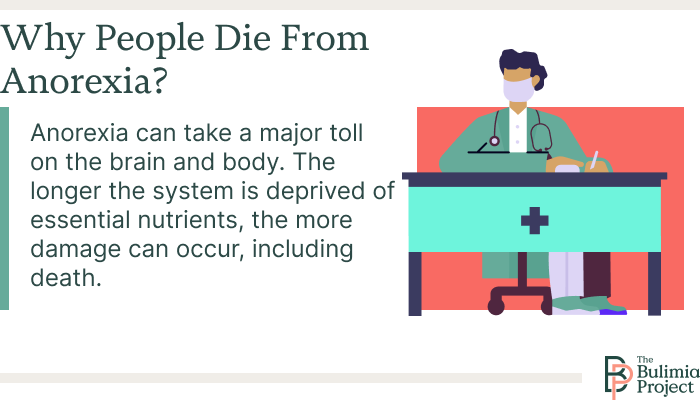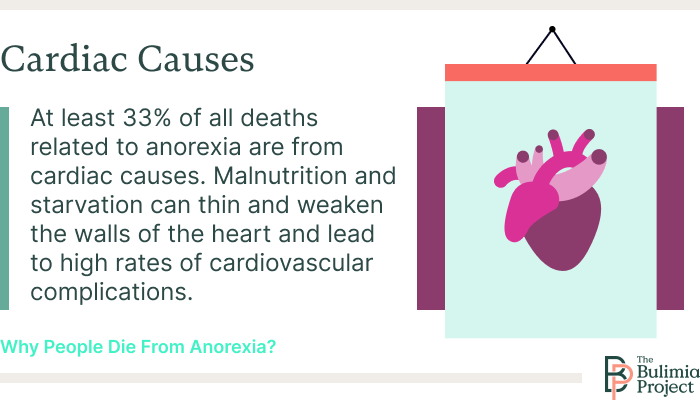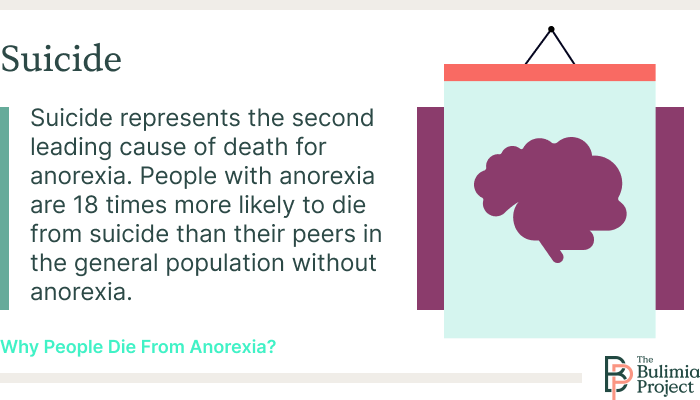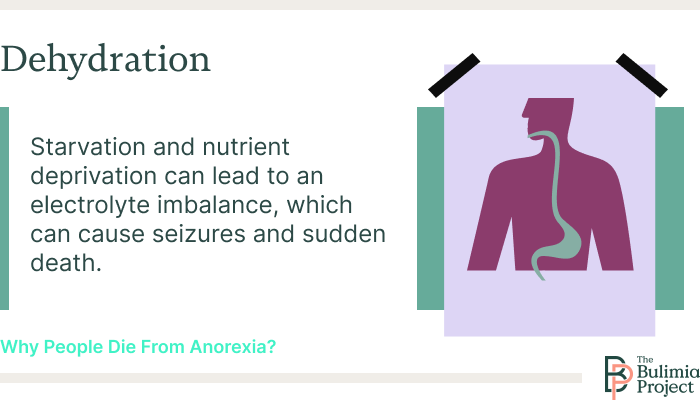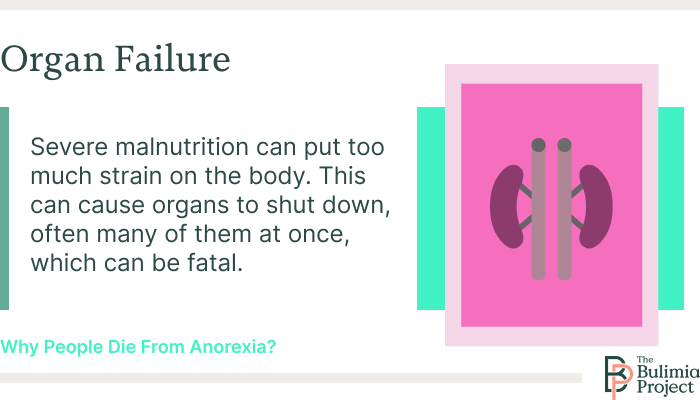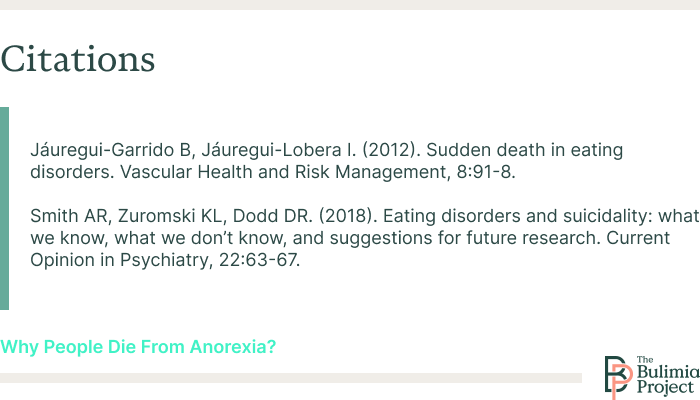Anorexia has the highest death and mortality rate of all eating disorders. The mortality rate for anorexia can range from 0.71 and 12.8. (3)
While women have anorexia more often than men, the mortality rate for males with anorexia is double that of females. Worldwide, eating disorders cost more than 3.3 million healthy life years annually. (4)
There are many factors that can contribute to death from anorexia. Early intervention and treatment are essential to minimize the risks.
Why Do People Die From Anorexia?
Anorexia can take a major toll on the brain and body. The longer the system is deprived of essential nutrients, the more damage can occur.
This can lead to organ damage, brain shrinkage, and issues with the nervous, endocrine, and cardiovascular systems. It can also cause significant mental health issues like depression and anxiety.
- Cardiac causes: At least a third of all deaths related to anorexia are from cardiac causes, most often from sudden death. (6) Malnutrition and starvation can thin and weaken the walls of the heart and lead to high rates of cardiovascular complications.
- Suicide: Suicide represents the second leading cause of death for anorexia. (7) People with anorexia are 18 times more likely to die from suicide than their peers in the general population without anorexia.
- Dehydration: Starvation and nutrient deprivation can lead to an electrolyte imbalance, which can cause seizures and sudden death.
- Organ failure: Severe malnutrition can put too much strain on the body. This can cause organs to shut down, often many of them at once, which can be fatal.
The more severe anorexia is, the greater the odds of fatality. People who enter treatment with “extreme” anorexia—with a BMI of 15 kg/m2 (8) or less—are more likely to die from refeeding or complications related to anorexia.
How Are Anorexia Mortality Rates Calculated?
Mortality rates for anorexia take the number of deaths within a specific population—typically meaning an inpatient treatment center or geographic region like the catchment area near a specific hospital—and divide them by the number of expected deaths in the general population.
Specific demographics and hazard ratios for the disorder are considered. This is calculated by dividing the rate of hazards in the eating disorder group against the rate of hazards in the control group or the general population.
Mortality rates for anorexia can be influenced by the following:
- Age: Older ages have a higher mortality rate.
- Weight: Low BMI can increase the risk of death.
- The severity of the disorder: The more severe, prolonged, and chronic anorexia is, the more likely it is to have life-threatening consequences.
- Co-occurring disorders: The risk for death goes up with the presence of another mental health disorder.
Are Anorexia Death Rates Accurate?
Anorexia death rates are likely lower than the actual number of fatalities related to the eating disorder.
Eating disorders are likely underreported and undertreated, especially in men, which can skew the numbers since mortality rates are often calculated based on those in treatment.
Deaths related to anorexia are often caused by physical factors, such as heart failure, and the actual trigger (malnutrition or food deprivation) may be overlooked or go unnoticed.
The high rate of “sudden death” where autopsies cannot determine or clarify the absolute cause of death and the number of suicides associated with anorexia makes it difficult to get an accurate count of deaths that are actually related to the disorder.
In short, anorexia death and mortality rates are already reported to be high. It is highly likely that they are even higher than the research indicates.
What Is Being Done to Lower Anorexia Death Rates?
Lowering anorexia death rates starts with prevention and educating people on the potential dangers of this disorder.
Catching potential disordered eating and distorted body image issues early by knowing the possible warning signs of an eating disorder can be lifesaving. It is also necessary to remove any potential barriers to treatment, which can include the stigma associated with mental health and eating disorders.
The earlier a person gets treatment for anorexia, the better the outcomes will be and the lower the risk for death. Since so many deaths from anorexia occur suddenly and without warning, early intervention is vital to address malnutrition as quickly as possible. Early treatment enables the body and brain to start to heal and increases the likelihood of reversing some of the negative side effects.
Treatment Methods
Comprehensive treatment methods are essential for managing anorexia on a long-term basis. Co-occurring mental health issues and the rate of suicide are very high for people with anorexia.
It is incredibly important to ensure that those in recovery have the right level of support. This can include:
- Behavioral therapies
- Counseling
- Medications
- Medical management
- Support groups
With proper treatment, most of the damage to the brain and body related to anorexia and starvation can be reversed. With ongoing support, people can maintain long-term recovery from anorexia.
Resources
- Eating Disorder Statistics. (2021). National Association of Anorexia Nervosa and Associated Disorders (ANAD).
- Eating Disorder Statistics. (October 2020). GenPsych.
- Arcelus J, Mitchell AJ, Wales J, Nielsen S. (2011). Mortality Rates in Patients With Anorexia Nervosa and Other Eating Disorders: A Meta-analysis of 36 Studies. Arch Gen Psychiatry, 68(7):724–731.
- Edakubo S, Fushimi K. (2020). Mortality and risk assessment for anorexia nervosa in acute-care hospitals: a nationwide administrative database analysis. BMC Psychiatry, 20( 19).
- van Hoeken D, Hoek HW. (2020). Review of the burden of eating disorders: mortality, disability, costs, quality of life, and family burden. Current Opinion in Psychiatry, 33(6):521-527.
- Jáuregui-Garrido B, Jáuregui-Lobera I. (2012). Sudden death in eating disorders. Vascular Health and Risk Management, 8:91-8.
- Smith AR, Zuromski KL, Dodd DR. (2018). Eating disorders and suicidality: what we know, what we don’t know, and suggestions for future research. Current Opinion in Psychiatry, 22:63-67.
- Machado PP, Grilo CM, Crosby RD. (2017). Evaluation of the DSM-5 Severity Indicator for Anorexia Nervosa. European Eating Disorders Review, 25(3):221-223.
- Why Early Intervention for Eating Disorders Is Essential. (2022). National Eating Disorders Association (NEDA).
- de Jong M, Spinhoven P, Korrelboom K, Deen M, van der Meer I, Danner UN, van der Schuur S, Schoorl M, Hoek HW. (2020). Effectiveness of Enhanced Cognitive Behavior Therapy for Eating Disorders: A Randomized Controlled Trial. The International Journal of Eating Disorders, 53(5):447-457.
